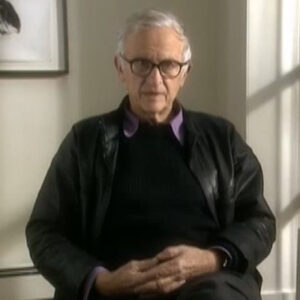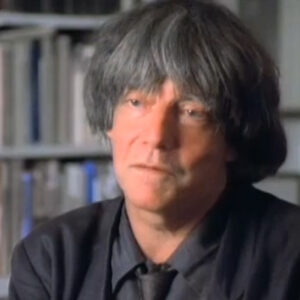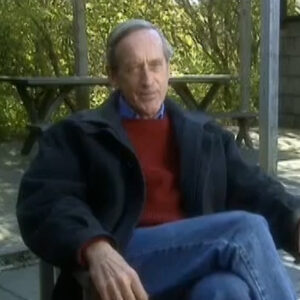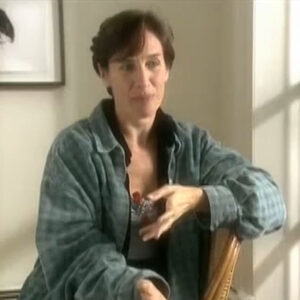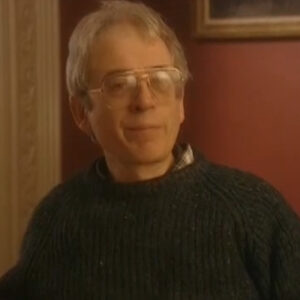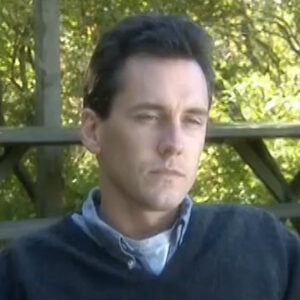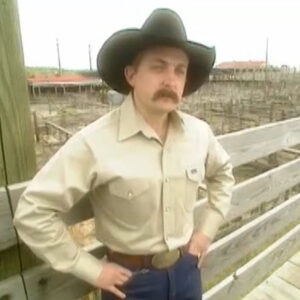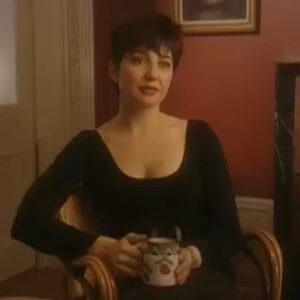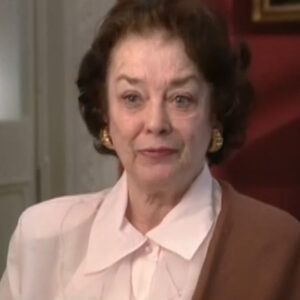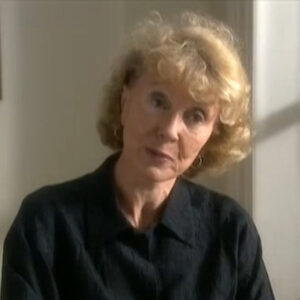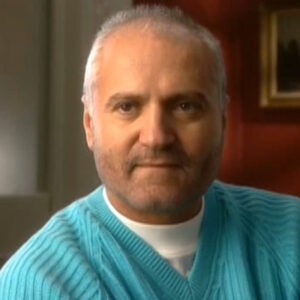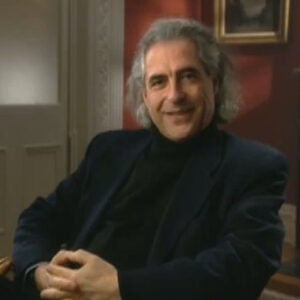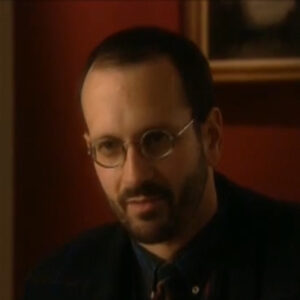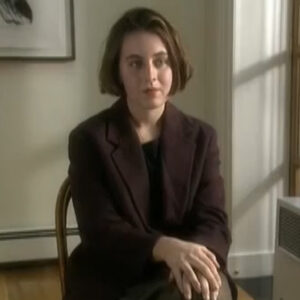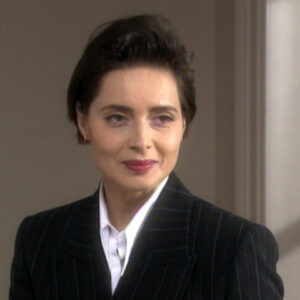Speaker I was raised in a studio. Um, you know, I had my mother originally was the art director of Junior Bazaar. She was very closely connected with Breivik. He was her mentor. And, um. When before I was born, she brought Dick into the bazaar along with Broadbridge. I don’t know which way. I mean, they were there. They’d been friends for a long time. And my father was also a photographer and.
Speaker When I was born, after Johnny was born, after Dixon was born, I mean, there was always a sense of two running families, studios, you know, the sort of the the child who runs into the studio and disrupts everything, you know, makes a mess and sort of is intrusive. I don’t know how Johnny behaved in this studio. I was very bad. And I think my early memories are was that it was more fun to play with assistance than to try and get, you know, your parents or any other photographers attention on, you know, what you were doing as a child. Sort of made me not want to be a photographer, sort of hated all those models and nothing. My brother had the same reaction. I think he liked the models. I always hated that. And I sort of hated that whole. Distraction for me. You know, and sort of we started painting early and got out of it now I think later on I discovered, you know, I guess through. Hearing lots of stories about Avidan and Radovich, as you know, sort of later on in, you know, sort of 18, 19, that it wasn’t just models, it was more to do with a view of life and sort of actually getting to do what you want to do and be paid for it. Sort of you know, they seem they all seem to have a lot of fun, you know, and in the end, run in the little crazy sometimes. But. And I I remember hearing lots of stories about, well, Dick went to Paris to shoot collections and, you know, meet the editor with Roses and Champagne. And it all seemed very romantic, you know, sort of this, you know, pretty lifestyle.
Speaker And then when I started looking at earlier work of, you know, not earlier work, but the more political work of dates and the more political work of my fathers, I started to get much more interested in the relationship of what you could do with fashion, what and the influences of the time and still work within the same field. You know, I find Dick’s Pictures and my father’s pictures and my mother’s picture was politically appropriate, whereas I don’t find a lot of fashion photography edgy or controversial or. And I think it made me look at fashion differently. It also made me look at a lot of other things differently. Along with painters that I was influenced by were you know, I always think of them as the the same set as Warhol and, you know, whatever was slightly more cutting edge than the mainstream. And they were important influences to me when I was going to art school.
Speaker And then later when I decided to become a photographer, I had a I had I mean, I have a fairly within the realm of what I was doing, a fairly established name and doing sort of commercial work. And I found that what I had started to love and photography, I had sort of lost. I mean, when I first started, I carried a camera all the time and I was always taking pictures and I always had a project. And I hadn’t been doing that in the last two or three years. And when Amy called me up and said that Dick was giving a class and I said, well, I can’t get into that class, he knows me, it’s gonna be like nepotism in a way. I mean, it’s like, you know, I’ll never be sure whether he picked me because he liked the photographs or because, you know, I’m really embarrassment and call him his daughter. And I sort of decided I would just send in a portfolio and see what happened. And I must say that my mother pushed a lot. She said Dick is a person who does his personal work and he does his commercial work and he doesn’t stop doing one for the other. And you’re in a rut. You don’t like it. And he’s the person who’s who would probably kick your ass more than anybody else. And so I sent in a portfolio with a lot of reservations because I felt that the family relationship might interfere because I didn’t want to be treated more special than anybody else. I also didn’t want to be attacked because he knew me as a child and I didn’t know whether he would ever think of me as an adult because I was around as a child. You know, when there is a you know, I’ve gotten a lot from our directors at the beginning, you know, I don’t tell anybody, but, you know, it comes up EUR William batsman, Polhemus daughter. Oh, what was it like? Know, proud of it. And you never feel like you can establish an identity pass that. You know, they don’t. They look at you as 12 years old. They don’t look at you is thirty five, you know, with a different background, you know, with. Yes. Their background, but also what you’ve added to it as your own experience.
Speaker Tell me how to get you out of that.
Speaker I think it was watching his energy.
Speaker That’s my question for.
Speaker Dick is really amazing to watch, it sort of makes you re-examine how you approach things. Anything that you might have had fear of doing, you no longer have you watch him overcome that fear all the time. I mean, he must have some fear that whatever it is in front of him won’t happen. What he expects won’t materialize. I mean, I don’t think a photographer ever loses that. Sort of intense moment of is that subject really going to be just a blob? What is it? Are you never gonna be able to move it past that? Are you never gonna make that image happen? You know, the combination of one to the other. And I think watching Dick made me experiment more. It made me question.
Speaker A more.
Speaker A more direct, confrontational attitude. It made me realize that if I tried something and I failed, it wasn’t the end of the world. Though Dick sometimes made you feel it was the. But it. I’ve never believed that criticism is bad. So I don’t find his method of teaching, which is very critical, a bad method. I mean, I find it kind of I mean, I always found it did better with my painting teachers that were much harder on me than I did with the ones who loved everything. But that’s a very also a very broad image. I mean, you know, if you don’t cry during class, nothing’s been accomplished. I mean, if your whole ego structure hasn’t been torn down and ripped apart. You know, you’re something is wrong. You know, you haven’t succeeded in your in what you wanted to do to your student. It’s sort of a very controversial attack. But it also makes you stronger in the end. It makes you look at what you’re doing. Clearer. It makes you more critical, which I think some people are lax. I mean, there are a school of people who think everything they touch is fabulous. Dick will only fall into that when he is do a commercial job. Bennett is fabulous no matter what it takes. You always see it in the edge. Well, is it absolutely fine? Well, no. It’s fabulous. He’s much more questioning of his own. Is this the right print you saw in the when he was picking Steve Martin? Was this. I picked really fast. Did I ultimately pick the right image? You know, there’s always this going back to negatives. There’s always this going back to an image. And that’s really helpful because, you know, you can look at something one minute and it’s something else and then you can go back to it. And it has a different connotation. You’ve had time to think about it. You’ve had time to put it into context. It’s already been out there and you re-evaluate and you redefine what you’re doing.
Speaker So no more than my mother.
Speaker I mean, my mother makes her students cry all the time. I mean, there is this school. I took a course with lives, that model. It’s the flip side of Dick when she was alive. She was incredibly gentle and it was a sort of more Buddhist form of meditation. I mean, she would sort of slowly bring you around. And her end result was the same. Her end result was was good. I mean, it’s two totally different methods of teaching. Hers was an organic. Let’s let’s push you to the next step slowly. Let’s let you grow with it. Everything was I mean, everything was OK with her. Just it wasn’t quite right. You could take it a little bit this way. Let me let me direct. You wanted to go have coffee at the Lower East Side, maybe bring your camera, maybe sit there for an hour, then come back and sort of develop your film and see what you’ve like, discovered Dix’s. Get down there, shoot the job and get it over with, you know, and make it brilliant. It’s a totally different method of teaching. You know, it’s much you know, it’s like, you know, the frying pan in the fire. It’s it’s, you know. And I, you know, you have to there’s a Masters class. Nobody should be in there who’s got a fragile ego. That wasn’t. I mean, none of the reports on deck should have ever let anybody to believe that he was gonna be gentle. You know, it’s like not known that he’s gentle, sweet, charming, you know, seductive, whatever. Yes. Easy. No. I mean, you know, he comes from and everybody knows the history. I mean, these are kids who, you know, they’re adults. You know what all of the history has been. I mean, they’ve read about Radovich. They’re not uninformed.
Speaker They knew what they were getting into your stuff and said, well, agreements with reference.
Speaker We have an artistic difference. I mean, underlying everything. As I said about Eileen’s pictures when her pictures were up. I have a very strong early influence of abstract artists and conceptual work. I went to SBA. I studied with Joseph, forsooth. I mean, you know, I was a wreck. You know, I was an assistant to Rauschenberg. I mean, I have a very I enjoy that kind of work. That kind of work intellectually stimulates me. I have. It touches my soul also. I mean, I see what I want to see in it. Dick is not an abstract mind. He is a representational mind. It’s about ideas. It’s about direct confrontation of those ideas. It’s just a different mind. I mean, I like, you know, light shows that just have to do with light. It’s something that I don’t know if you’re not if it’s not part of your what you are drawn to, whether you would. So, you know, I have a lot of friends and I used to do performance art. I did some work with, you know, in the ontological, hysterical theater. I think that Dick enjoys watching the performance of that kind of thing. But when it comes to photography, it’s much more about certain kinds of work. And they’re not abstract. They’re just it’s not that kind of work. And he’s not interested in it. I mean, he doesn’t have to be, you know. But I think that what ends up happening is, is that the students generally generate to what he will critique, you know, and what he will get involved with. And I don’t think that he would get involved with that. I mean, this wasn’t a still have class. I mean, you know, it wasn’t, you know, an abstract. I mean, the categories were very specific when it started.
Speaker You know, it’s and they’re traditional. What was the work?
Speaker Eileen showed in the last in the last week at the autofocus, pictures that looked like sort of blown up snapshots. And I don’t think they were printed in what she wanted them printed. I mean, I don’t think the end result is there yet. But he didn’t understand. I mean, he understood it. He just didn’t want it, you know. He understood it. It’s not like he doesn’t understand it. It’s that it doesn’t it doesn’t touch it. So he doesn’t want it. You know, he wants her to go further for her. I mean, it’s it’s a you know, you go to it, you go to different teachers for different things.
Speaker We had your pictures up on the stand right now.
Speaker The pictures that you might feel showed that you were right, that you weren’t happy with. And then a picture that was a transitional picture.
Speaker Midway through, tactic scores simply go on, just describe how the work has changed. It’s loosened up a lot.
Speaker But specifically described maybe one pitcher if we had it up on the stand right now that you were dissatisfied with another pitcher that you feel is losing up so we can imagine the futures in front of us. Describe them for free and how they changed over the last year or two.
Speaker Well.
Speaker I guess there was a picture that I took of a of and I think it’s one of the pictures that Dick liked that got me into the class, but it was Volter picture and a much older picture. I mean, it was done about seven or eight years ago. And it was a picture of of a laundry hamper going down the street and a man’s legs hanging out of it. And it was a picture that I just happened to see. It was a homeless guy and it was rolling down the street with taxicabs and traffic and everything about it is what I believe in, in photography. It’s the camera is a sketchbook. It’s your relationship with the world via a camera. It’s a recording of a time. It’s a tool. And it’s, you know, like sort of a mental diary. You know, it’s sort of like a physical. You carry it and you record.
Speaker And I lost that doing commercial work. And it’s one of the reasons I took Dick’s class.
Speaker The second picture I did when I you know, because of his assignments, I had to get back out on the street. I mean, without assistance and without whatever. And I his second assignment was to photograph your family. So I did this sort of picture of my mother, and he sort of liked the straighter picture. And I liked that I had played in the darkroom again. I had like that I had felt the freedom within a class because I wasn’t doing an assignment and because I mean, an assignment out for commercial work that, you know, this was my you know, and I sort of began to like it, but I felt that it was still too commercial, that it still sort of had that. And I think that that was it was the portrait of my mother that I showed you that in some ways he was very right about the critique that what I what what I dismissed in the contact was to make it prettier, to make it more surreal, to make it more of an icon, which was not my original intention with photography. The third picture, which I do think I like a lot, was the series I did on the Lisette model, like pictures, which I really ran around in subway stations and everywhere else and photographed feet. And I was rediscovering what I liked in my first pictures, which is always something that I find in photography and in art, that your initial work, whether it’s there technically or not. Has all the elements of what you’re going to later be doing. You know, the original interest. I mean, you can develop ideas that build into it. But that childhood instinct, that freshness, I think, is what photographers are always trying to recapture, that real initial love, that real initial, non jaded moment. And it’s hard to find it again. And I think that the street assignment really helped me. I mean, I ended up with. Yes. Chic elongated leg, but there was something back to the freshness. There was something that was that he had given back, that there was a sense of play about it. There was a sense of finding out that I loved the street again, that there were still new things out there, that there were things that I could utilize still. And I had been getting way too jaded.
Speaker You know, Dick always was. You know, he’ll go to Brandenberg. You know, the event interests him on a plane. I mean, the biggest thing I learned from Dick was he’s always interested. He is never jaded. There is always something there that he can hop on a plane and go and photograph or go around the corner and drag somebody in. I mean, you get the commercial assignments. It funds the play work. You know, he’ll go and he’ll take a crew and he’ll go out west and photograph everybody, you know, that he’s interested in. It’s an immense gift to see somebody photograph him for 40 years, you know, and keep that kind of. It’s more than 40. More than 40, you know. And keep that sense of every. It’s always a new moment. That is like the hardest thing in the world.
Speaker The year before reassigns all to choose male, female, so I took a picture of it was distinguished early on, you could tell that Eileen and Dick.
Speaker Had a connection. And I took a picture of the two of them together. I think they happened to look immensely similar.
Speaker And look, I, I have the picture. I think Dick has the picture, too. But it’s sort of I don’t know if it’s the male female as much as the identity that everybody has both sexes in. I think that what he sees in her, he sees in himself.
Speaker What you know, there’s this sort of.
Speaker It’s sort of I don’t know, it’s just an identity. It’s like recognizing another soul that’s very similar. Oh, I think he liked it. I don’t think that he thought it was the world’s greatest picture. I don’t think it’s the world’s greatest picture. What I think about it is, is that it shows a relationship between the two of them. You know, not everything.
Speaker I think we’re not growing up. There are a lot of issues I love that have nothing to do with being great pictures. They have to do with an element of recognizing a relationship as being true. You know, you can find it in every snapshot book. There’s one picture that’s not a great picture. Structure isn’t right. The lighting isn’t right. Something’s not right about it. We have those views of what’s right about work. But there is also an element of truth that happens in certain of those images that you get attached to that you recognize. And I think that there is a small sketch in there that to me reads of their relationship as truthful, you know, not not a fashion picture, not a you know, not a made up idea, but what is really their relationship.
Speaker I mean, I may be wrong, mate, Dick may have a totally different attitude about it.
Speaker And your own response to that finished photograph? I know, uh.
Speaker You really want to put me on the spot, OK?
Speaker I don’t find it shocking. I’ve seen many. I think it’s a beautiful picture. Let’s start with this. I do think it’s a beautiful picture. OK. One of the problems with me having. The fashion part of an experience is that I was raised in a fashion studio. So everything that interests.
Speaker The class about what went on that day. I was raised in, I hate me, a hair and makeup people, I usually hate models. I mean, I have some really good friends. But I hate that whole Michigan’s. I mean, I. The end result is great. But the time, the boredom, the. Unless you were shooting it. And I do occasionally shoot fashion is ultimately immensely boring. If you’ve been raised in it, I mean, it’s. You know, it’s it’s like, you know, I did some film work, I was an assistant on some film, and everybody thinks that film is really romantic. Everything is shot out of sequence. It’s really boring to watch a film being shot. It’s like being in the army and bootcamp. I mean, you know, everybody has their job. Everybody does their job. And if you’re interested in your job and you’re involved in the shoot, it’s great to sit there and watch. It is not great unless you’ve never seen it done before. I’ve seen shoots before. I was interested in seeing Dick work with Stephanie because I think that was he hadn’t worked with her that much. I think you only worked with her one time before. And it was interesting to watch him work once he got started working. And I did find that interesting. I think that one. When you’re watching a director direct. That’s when it becomes interesting. The other stuff is, you know, 50 million hours of boredom and then those to watch that instant of when it happens between a subject and a photographer or a subject and a director. That’s what’s interesting. Then you watch carefully because then what makes his pictures different is going to show someone.
Speaker I felt a little bit cheated because with 15 people watching that are not directly involved in the shoot, you know, his assistants around in the crew, random is one thing when he knows. That there is something else happening. You don’t really see.
Speaker What’s the method?
Speaker It has to be more personal than that. See it really happen. The picture, I think, is beautiful. As a woman, I would rather have seen her laughing. The picture that I was much more interested in was the picture of Stephanie with the tits flying with her on her toes, which is the picture that he sometimes uses opposite it, which has the energy and the passion and the femaleness and the power that I.
Speaker The other pictures, too, still for me. The picture of Stephanie with she’s wearing a black dress. It’s a very architectural picture, sculptured picture, and she’s lifting up her dress and her I guess her Bush is showing. It’s very outwardly, it’s very confrontational.
Speaker But it’s not confrontational to me.
Speaker I think it’s beautiful, but I don’t think it hits sexuality for me, it it doesn’t hit some of the power of the other pictures of the tip.
Speaker The verse. Who is it? Lauren Hutton with the breasts coming out, which I find intensely erotic. You know, I find that it’s always been one of my favorite pictures for the time it was shot for the fact of who it is for this incredible. Entrance to the foreground. It’s so out there. I mean, it is so. This is who I am. And there was also a picture of who is it? Who’s tweeting her to.
Speaker He’s he did a marvelous picture, and I I should know who it is of a woman holding up her dress and she’s holding her two. Her nipple.
Speaker Actually, she’s squeezing her nipple. There is more of a gesture and there are more faces. I think that in the Lauren Hutton, when you don’t see the face, but you see I mean, at the time it was I mean, I had never seen anything like it. You know, other than Fellini, you know, with I just thought it was I thought this is what every woman should see. This is what every woman should, like, be like. This is earthy. This is fabulous.
Speaker The coldness of Stephanie in the last picture and the alienation, which is not what Dixy, isn’t it?
Speaker It’s what I see in it because of my view of models. She’s a model. And it bothers me if it’s somebody else doing that. It wouldn’t bother me. But in later on during his sessions with Stephanie, she’s become more of something. This one or the Stephanie thing?
Speaker It’s the love of the moment. It’s the initial. It’s the first chording year. He discovered a model he could work with that day. He found a model of his own again.
Speaker I mean, not that there wasn’t probably one, two weeks before that he found somebody that he loved that day. Hence, that picture reminds him of that day. This is my opinion. You know, it’s that initial discovery. It’s the first date. It’s everything he remembers about the first day. It’s to get a picture like that out of a first shooting is amazing. And what it went from at the beginning to a girl he felt couldn’t move for him in the motion. He didn’t you know, he usually works with a model longer to do motion pictures because he wanted to do a motion, you know, a running picture movement picture for the class. And that wasn’t working so well because she didn’t know how to move for him and he didn’t have enough time. You know, in three hours. I mean, he’s trained a lot of models to move for him because he doesn’t like, you know, he gestures important to how they move is important to him.
Speaker I could see during that shoot it’s starting. He could find her. She was malleable enough. She could make him his. She could make he could make her his. She was available to it, and I think that’s what the picture means to him for her to do that on a first shoot.
Speaker For him, I think, was an immense amount of trust on her part, even with the sexual revolution and even with everybody taking off their clothes. And it meant something emotionally to him. I think. I mean, this is my opinion. So I think that that’s. And to get a good picture, to get a really good picture out of a fur shoot, you you tend to love it. I mean, you tend to love the woman. You tend to love the man. You tend to you know, you’ve you’ve allowed a connection.
Speaker And I think that’s what it means to the subtext. What about the text? Does he feel this picture says what she’s saying?
Speaker Well, I know what he says about it. He says what he sees in it is. A woman who’s not afraid to show her sexuality and this still who she is, she’s not a piece of meat. She’s a forthright, strong woman who has a complete sense of herself.
Speaker That’s what I mean, he said he he sees in it now everybody’s going to read something different into what they see in it because they bring their own set of background to what they see in it. I see a model in it. That’s what upsets me about it. So I see something different in it than he sees.
Speaker Is the idea for this picture, this picture A with the.
Speaker Or was it something he was clear about from the very beginning?
Speaker I don’t know. And I wouldn’t begin to fathom with Dick whether this was totally premeditated or not. He made it appear that it wasn’t.
Speaker He made it appear that it wasn’t. And it might have been an organic thing that happened over the shoot.
Speaker But I don’t know. I mean, Dick is brilliant.
Speaker There’s no question that he couldn’t have decided the night before or, you know, he saw the clothes, the date. You know, he looked at the clock. I mean. Yeah. No, that’s not true.
Speaker Most of the clothes came in that morning, but he had she had told him what? Polly and told him what was coming in.
Speaker He’s he I mean, it may not have been determined by the clothes, though, that, you know, the dress was very absolutely See-Through, but black. So I you know, I don’t know. You know, I think that organically grew.
Speaker I didn’t I. I don’t know. He might have wanted her to reveal something and didn’t know whether it would happen or not. You know, I think he thought about he had started out with the idea of a pre Rafie like a woman of the 90s as a pre rafeal life, which is that there was all this hair. And I think he found during that shoot that that wasn’t working. That wasn’t giving him a strong enough image. So it sort of started it got tougher and tougher. The Parafield like disappeared. The leather boots D.A. came on the strong 90s shoes. You know, those boots like those army boot like things. And then it became a black Schirò dress with hair pulled back. I mean, it was very different than what he had initially seen her as. And this happened all within three hours. No, we’ll skip hair and makeup. You know, the shooting part.
Speaker Did you see anything?
Speaker Was there any?
Speaker Yeah, I learned that he just didn’t stop pushing her. I mean, and it was very subtle, but he didn’t break her down when the pre Rafiah light wasn’t working.
Speaker He very suddenly changed her attitude. You know.
Speaker As he said, the Parafield Light was just pretty. It was just beautiful and he didn’t flip out over it. He didn’t. You didn’t, Sener, you know, other than hyped in nervousness about shooting, you know, which is the keyed up feeling he didn’t.
Speaker It was like this organic thing that kept moving. Let’s. This isn’t working. Let’s shift it. Let’s put it this way. Let’s move her this way. Let’s let’s get her a little bit more intense. Let’s lead her there. You know.
Speaker At this point in his life, age 71. It’s been a long while since he’s ever told.
Speaker I think he wants. To leave a mark. You know, I think he wants.
Speaker I think most people who are. Brilliant photographers or brilliant painters? Now, that’s not true. Take that back, because Penn never wanted to teach me. He has no desire to. I think that he gets a lot. First of all, the studio is a young studio. I think he likes influence. He’s got friends in every sect. Of. You know, professions. Andre Gregory is, you know, film, dance. I mean, there isn’t a feel that he’s not interested in. And I, I think that the energy that you get from teaching and I think there’s a lot of energy that you get from teaching he wanted. And I think he wanted to watch. Right. Teaching books. I think he has something to say about it. I think, you know, it’s one thing to do your own work and have it out there in museums. It’s another thing to leave a legacy of a different sort. So I think he went one in another legacy. Pass something on. He’s a generous man, you know, and I think he’ll get something out of doing that.
Speaker Yes.
Speaker Yeah, it’s not it’s probably not his favorite picture, but there was a picture he did, of course. I’m terrible with remembering names, but it’s the one with a contortionist in Paris and she’s walking. And there’s a there’s a there’s a woman in a dress walking down the street and he’s sitting on the table, the contortionist, and he’s all bent over. And I remember looking at that picture when I was like eight years old or seven years old. And you have to understand that I was raised in a fashion studio. So I had seen a lot of fashion images. And the fact that he did this incredibly elegant woman with this very funny contortionist. I just loved. I mean it. I just adored it. I mean, I found it so compelling, the juxtaposition of something slightly awkward and ugly with something so elegant and this sort of I loved the fact of those early pictures of the women doing real things. Of them not you know, they weren’t always there was always something slightly off about them. They weren’t this, like, perfect. What at the time was these perfect models standing, these perfect waves? They always had something slightly awkward, slightly not the. There were real faces to me. That was something that I wasn’t. It’s something that I started to look at in my father’s work and something. And it started to look at work when I was younger. And I think that energy, you know, and then when I started with the white pictures, he did a picture of the this model with the French press behind him. You know, the paparazzi’s those are moments. Those were the first moments of those kind of photographs that I hadn’t seen. They were new. You’ve seen people copy them and copy them well. I mean, you know, but they were the first I had ever seen. And he was the first to do those. And there were those were always exciting. You know, people leaping out of the corner of a frame, you know, wasn’t dead center, you know? And it’s a broad vich influence and it’s, you know, it’s a combination. But there was something about the energy and the lack of. Direct beauty, there was always something else going on that I really appreciated young and influenced me. Young people weren’t doing that kind of work.
Speaker The question, do you feel as it is today? Sometimes when he talks about who’s support richer, he wants it both ways.
Speaker Yeah, but everybody wants it both ways. You know, you want the truth, but you also wanted to be a great portrait lot of the times there. It’s not a great you know, the moment isn’t great. So you try and make it great. So there is a lack of truth that you don’t longer get because you’re making it a great picture.
Speaker I mean, that’s my theory of it, you know, because truth is not always interesting. Truth can be very boring. Boredom exists in the world and people are afraid of showing boredom because then it looks boring.
Speaker You know, it’s like going back to Waiting for Godot.
Speaker You can wait and you can wait.
Speaker And you can wait and you can wait. And sometimes nothing happens. And as a photographer, I think that Dick wants something to happen.
Speaker So he moves it. And maybe there isn’t the same truth involved anymore. But it’s a truth at the moment for him.
Speaker Yeah, because there many times you’ll say, oh, we have a surplus and it’s a great image and it’s about me. It’s my autobiography written on that. So. So he went back and forth, you have.
Speaker There’s nothing wrong with that. I mean, that’s what everybody. You know, I used to think I mean, everybody has ideas that fight each other.
Speaker You know, you want it to be truthful.
Speaker You want it to be interesting, which is going to take the higher way. You know, you want it to be about yourself. You want it to be about the purely about the other person. It’s hard to take a picture purely about the other person, you know, unless you set a camera in a room and leave the room and the person still knows that you’ve set up a camera and you’ve left the room. So they’re still dealing with you as something in their head. There is no such thing to me as. Not taking a self-portrait or letting yourself not influence that person. You are going to be an influence. And so it won’t be totally about them. You cannot I mean, the only are a couple of people I know who can really wipe themselves out, totally wipe themselves. And I think that there are moments when you’ve seen Robert Frank shoot that you don’t even know he’s there. I mean, he just like I saw him one shoot and he’s like. Where’s the person? I mean, you know, you can see the other person who is shooting have no idea that he exists. I mean, he just wipes himself out. There have been a few people like that that just wipe themselves out. And it’s a different kind of photography. He’s not really doing portraits. He’s doing reportage. There’s no I mean, the essence of a portrait is that you’re sitting for somebody, whether you’re sitting in a bathtub or you’re, you know, sitting out in a field or, you know, it depends on what your definition of portraiture is. You know, you’re always gonna be a presence in their mind. You’re not going to. You know, yeah, you want it both ways. You want that, you want to think that you can bring out that person and to get yourself. You can’t. You can try. And so that’s where the dichotomy comes in. Because what you can you know, I’ve wiped myself out as much as I can. I think that’s as much of the person as I can get. That doesn’t have to do with me. But then you do want to see yourself in the person. You do want to see their reaction to you.


